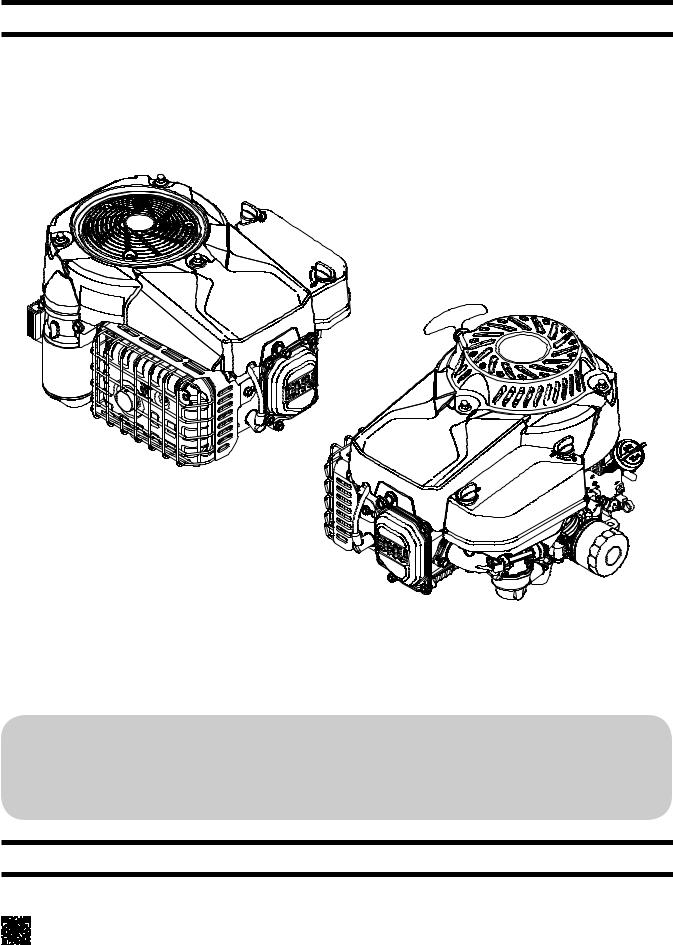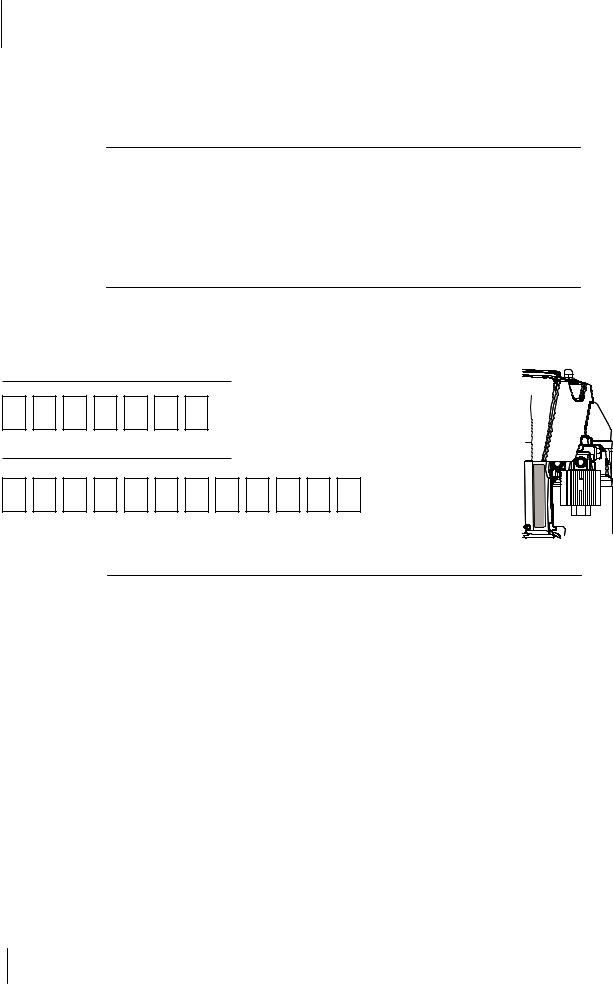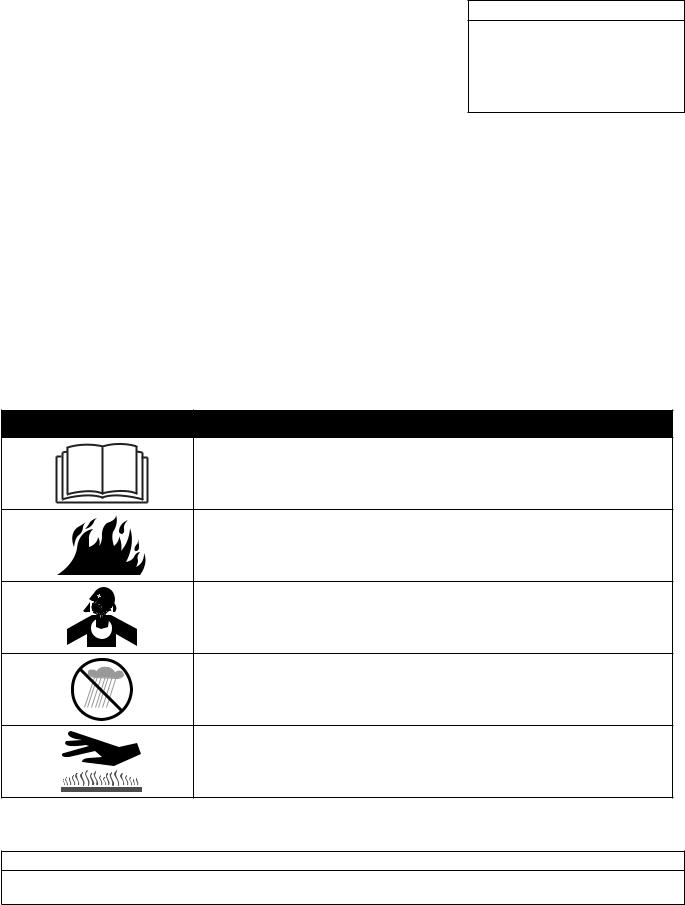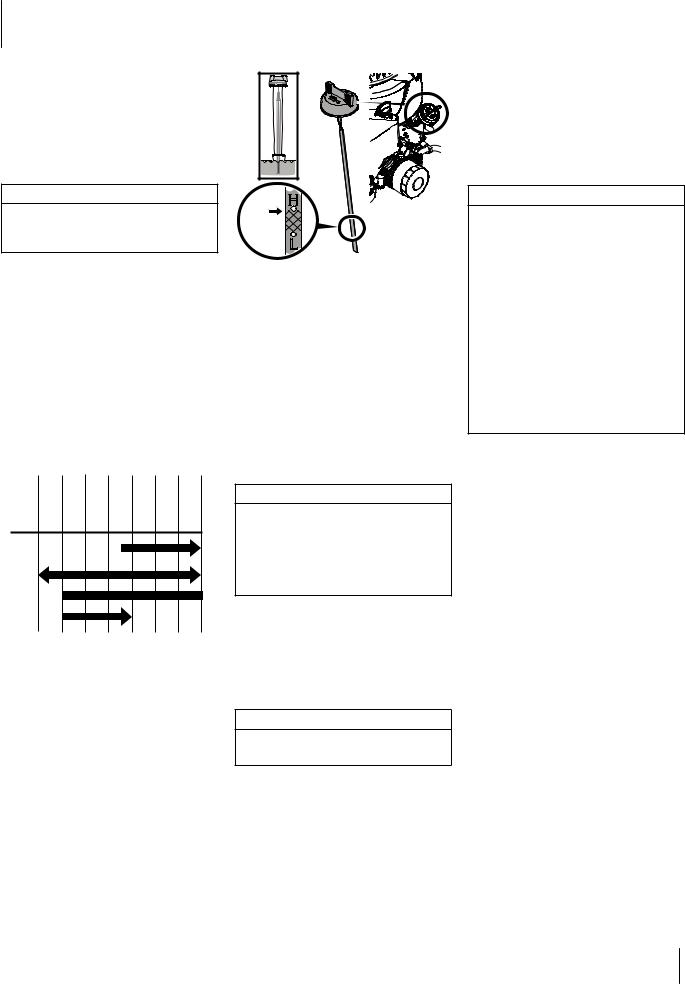MTD 13AB775S000 Owner’s Manual

Safe Operation Practices • Set-Up • Operation • Maintenance • Troubleshooting • Warranty
Operator’s Manual
382cc & 439cc OHV Vertical Shaft Engine
 WARNING
WARNING
READ AND FOLLOW ALL SAFETY RULES AND INSTRUCTIONS IN THIS MANUAL
BEFORE ATTEMPTING TO OPERATE THIS ENGINE.
FAILURE TO COMPLY WITH THESE INSTRUCTIONS MAY RESULT IN PERSONAL INJURY.
MTD LLC, P.O. BOX 361131 CLEVELAND, OHIO 44136-0019
Form No. 769-17451
(August 22, 2018)

To The Owner |
1 |
Thank You
This Operator’s Manual is an important part of your new engine. It will help you prepare and maintain the engine for the best performance. Please read and understand the contents before operating the engine.
Table of Contents
Important Safe Operation Practices....................................... |
3 |
Maintenance & Adjustments.................................................... |
8 |
Safety Labels.............................................................................. |
4 |
Troubleshooting...................................................................... |
12 |
Set-Up......................................................................................... |
5 |
Replacement Parts.................................................................. |
13 |
Controls & Features................................................................... |
6 |
Spanish..................................................................................... |
15 |
Operation................................................................................... |
7 |
|
|
Record Product Information
Before operating your new engine, please locate the model plate on the engine (shaded area in Figure below) and record the information in the provided area below. This information will be necessary, should you seek technical support via our web site or with your local dealer.
Model Number
Serial Number
Customer Support
Please do NOT return the machine to the retailer or dealer without first contacting the Customer Support Department.
If you have difficulty assembling this product, have questions regarding the controls, operation, or maintenance of this machine, want to order replacement parts/attachments/accessories, or want to view an online How-To video; you can seek help from the experts. Have your full model number and serial number ready. Choose from the options below:
•Web: www.mtdproducts.com/equipment/mtdproducts
•Phone: (800) 800-7310
•Mail: MTD LLC • P.O. Box 361131 • Cleveland, OH • 44136-0019
2

Important Safe Operation Practices |
2 |
 WARNING!
WARNING!
This symbol points out important safety instructions which, if not followed, could endanger the personal safety and/or property of yourself and others. Read and follow all instructions
in this manual before attempting to operate the equipment. Failure to comply with these instructions may result in personal injury. When you see this symbol. HEED ITS WARNING!
 WARNING!
WARNING!
CALIFORNIA PROPOSITION 65
Engine Exhaust, some of its constituents, and certain vehicle components contain or emit chemicals known to State of California to cause cancer and birth defects or other reproductive harm.
 DANGER!
DANGER!
This engine was built to be operated according to the safe operation practices in this manual. As with any type of power equipment, carelessness or error on the part of the operator can result in serious injury. Failure to observe the following safety instructions could result in serious injury or death.
Training
1.Read, understand and follow all instructions on the engine and in the manual(s) before attempting to assemble and operate. Keep this manual in a safe place for future and regular reference and for ordering replacement parts.
2.Be familiar with all controls and their proper operation. Know how to stop the engine and disengage them quickly.
3.Never allow children under 14 years of age to operate the engine. Children 14 and over should read and understand the instructions and safe operation practices in this manual and be trained and supervised by an adult.
4.Never allow adults to operate the machine without proper instruction.
5.Keep the area of operation clear of all persons, particularly small children and pets. Stop machine if anyone enters the area.
Preparation
1.Wear sturdy, rough-soled work shoes and close fitting slacks and shirts. Loose fitting clothes or jewelry can be caught in the moving parts. Never operate the machine in bare feet or sandals.
2.Disengage clutch levers and shift (if equipped) into neutral (“N”) before starting the engine.
3.Never leave the engine running while unattended.
4.Never attempt to make any adjustments while the engine is running, except where specifically recommended in the operator’s manual.
Safe Handling of Gasoline:
To avoid personal injury or property damage, use extreme care in handling gasoline. Gasoline is extremely flammable and the vapors are explosive. Serious personal injury can occur when gasoline is spilled on yourself and/or your clothes which can ignite. Wash your skin and change clothes immediately.
1.When adding fuel, turn engine OFF and let engine cool at least 2 minutes before removing the gas cap.
2.Fill fuel tank outdoors or in well ventilated area.
3.Use only an approved gasoline container.
4.Never fill containers inside a vehicle or on a truck or trailer bed with a plastic liner. Always place containers on the ground away from your vehicle before filling.
5.If possible, remove gas-powered equipment from the truck or trailer and refuel it on the ground. If this is not possible, then refuel such equipment on a trailer with a portable container, rather than from a gasoline dispenser nozzle.
6.Keep the nozzle in contact with the rim of the fuel tank or container opening at all times until fueling is complete. Do not use a nozzle lock-open device.
7.Do not overfill fuel tank. Fill tank to full as indicated by the fuel level indicator installed inside of the fuel tank or marked
on the tank. Do not over-fill to allow space for fuel expansion. On some models, a fuel level indicator may NOT be present, in this instance, fill the tank no more than 1/2 inch below the bottom of the filler neck to allow space for fuel expansion.
8.Replace fuel cap and tighten until the cap ratchets.
9.If gasoline is spilled, wipe it off the engine and the equipment. Move the machine to another area. Wait five minutes before starting the engine.
10.To reduce fire hazards, keep the machine free of grass , leaves or other debris build up. Clean up oil or fuel spillage and remove any fuel-soaked debris.
11.Keep gasoline away from sparks, open flames, pilot lights, heat, and other ignition sources.
12.Never fuel equipment indoors because flammable vapors will accumulate in the area.
13.Extinguish all cigarettes, cigars, pipes, and other sources of ignition.
14.Check fuel line, tank, cap, and fittings frequently for cracks or leaks. Replace if necessary.
Operation
1.When starting the engine, make sure spark plug, muffler, and fuel cap are in place.
2.Do not crank engine with spark plug removed.
3.If fuel spills, wait until it evaporates before starting engine.
4.Allow muffler, engine cylinder, and fins to cool before touching.
5.Keep children away from hot or running engines. They can suffer burns from a hot muffler.
6.Remove accumulated combustibles from muffler and cylinder area.
7.Operate equipment with all guards in place.
8.Keep hands and feet away from rotating parts.
9.Tie up long hair and remove jewelry.
10.Do not wear loose-fitting clothing, dangling drawstrings or items that could become caught.
11.When starting the engine, pull cord slowly until resistance is felt, then pull rapidly (if not electric start).
12.Remove all external equipment/engine loads before starting engine.
13.Direct coupled equipment components such as, but not limited to blades, impellers, pulleys, sprockets, etc., must be securely attached.
3

Maintenance & Storage
1.Keep the engine in safe working order
2.Allow the engine to cool at least five minutes before storing. Never tamper with safety devices. Check their proper operation regularly.
3.Check bolts and screws for proper tightness at frequent intervals to keep the engine in safe working condition. Visually inspect the engine for any damage.
4.Before cleaning, repairing or inspecting; stop the engine and make certain all moving parts have stopped. Disconnect the spark plug wire and ground it against the engine to prevent unintended starting.
5.Do not change the engine governor settings or over-speed the engine. The governor controls the maximum safe operating speed of the engine.
6.Maintain and replace safety and instruction labels as necessary.
7.Always refer to the operator’s manual for important details if the machine is to be stored for an extended period of time.
8.If the fuel tank has to be drained, do this outdoors.
9.Observe proper disposal laws and regulations for gas, oil, etc. to protect the environment.
Do not modify engine
To avoid serious injury or death, do not modify engine in any way. Tampering with the governor setting can lead to a runaway engine and cause it to operate at unsafe speeds. Never tamper with factory setting of engine governor.
Notice Regarding Emissions
Engines which are certified to comply with California and federal EPA emission regulations for SORE (Small Off Road Equipment) are certified to operate on regular unleaded gasoline, and may include the following emission control systems: Engine Modification (EM), Oxidizing Catalyst (OC), Secondary Air Injection (SAI) and Three Way Catalyst (TWC) if so equipped.
Spark Arrestor
 WARNING!
WARNING!
This machine is equipped with an internal combustion engine and should not be used on or near any unimproved forest-covered, brush
covered or grass-covered land unless the engine’s exhaust system is equipped with a spark arrestor meeting applicable local or state laws (if any).
If a spark arrestor is used, it should be maintained in effective working order by the operator. In the State of California the above is required by law (Section 4442 of the California Public Resources Code). Other states may have similar laws. Federal laws apply on federal lands.
A spark arrestor for the muffler is available through your nearest engine authorized service dealer or contact the service department, P.O. Box 361131 Cleveland, Ohio 44136-0019.
Safety Symbols
This page depicts and describes safety symbols that may appear on this product. Read, understand, and follow all instructions on the machine before attempting to assemble and operate.
Symbol |
Description |
READ THE OPERATOR’S MANUAL(S)
Read, understand, and follow all instructions in the manual(s) before attempting to assemble and operate.
WARNING—GASOLINE IS FLAMMABLE
Allow the engine to cool at least two minutes before refueling.
WARNING— CARBON MONOXIDE
Never run an engine indoors or in a poorly ventilated area. Engine exhaust contains carbon monoxide, an odorless and deadly gas.
WARNING— ELECTRICAL SHOCK
Do not use the engine’s electric starter in the rain.
WARNING— HOT SURFACE
Engine parts, especially the muffler, become extremely hot during operation. Allow engine and muffler to cool before touching.
 WARNING! - SAVE THESE INSTRUCTIONS!
WARNING! - SAVE THESE INSTRUCTIONS!
Your Responsibility — Restrict the use of this power machine to persons who read, understand and follow the warnings and instructions in this manual and on the machine.
4 |
|
Section 2 — Important Safe Operation Practices |
|
||
|
|
|

Set-Up |
3 |
Gas & Oil
NOTE: The engine is shipped without gasoline and with motor oil in the engine. However, you MUST check the oil level before operating. Be careful not to overfill. Running the engine with insufficient oil can cause serious engine damage and void the engine warranty.
 WARNING!
WARNING!
Always keep hands and feet clear of equipment moving parts. Do not use a pressurized starting fluid. Vapors are flammable.
Oil Recommendations
Before starting engine, check oil level. Refer to viscosity chart in Figure 3-1 for oil recommendations. Do not over-fill. Use a 4-stroke, or an equivalent high detergent, premium quality motor oil certified to meet or exceed U.S. automobile manufacturer’s requirements for service classification of a minimum level SJ (higher letter ratings are
acceptable such as SL and SM grades). Motor oil will display this designation on the container.
SAE 10W-30 is recommended for general, all temperature use. If single viscosity oil is used, select the appropriate viscosity for the average temperature in your area from the chart below.
|
|
|
|
|
30 |
|
|
|
|
|
Synthetic 5W-30 |
|
|
|
|
|
|
|
|
10W-30 |
|
|
|
|
|
5W-30 |
|
|
|
|
|
(ºC) -30º |
-20º |
-10º |
0º |
10º |
20º |
30º |
40º |
(ºF) -20º |
0º |
15º |
30º |
50º |
70º |
85º |
105º |
Figure 3-1
CAUTION: Do not use non-detergent oil or 2-stroke engine oil. It could shorten the engine’s service life.
NOTE: A 5w30 synthetic oil may be used to improve start ability for cold weather (temperatures below 400 F).
Checking Oil Level
NOTE: Be sure to check the oil while on a level surface with the engine stopped.
1.Remove the oil filler cap/dipstick and wipe the dipstick clean.
2.Insert the dipstick into the oil filler neck. Turn the dipstick a 1/4 turn into the locked position to fully seat. See Figure 3-2.
Upper
Level
Figure 3-2
3.Remove dipstick to check the oil level.
4.If the level is low, slowly add oil to the upper limit on the dipstick. See Figure 3-2 inset.
5.Reinsert the dipstick and turn to the locked position before starting the engine.
NOTE: Do not overfill. Overfilling with oil may cause smoking, hard starting, spark plug fouling, hydraulic lock, or oil saturation of air cleaner.
Fuel Requirements
 CAUTION
CAUTION
Operating the engine with E15 or E85 fuel, an oil/ gasoline mixture, dirty gasoline, or gasoline over 30 days old without fuel stabilizing additive may result in damage to your engine’s carburetor. Subsequent damage would not be covered under the manufacturer’s warranty.
Use automotive gasoline (unleaded or low leaded to minimize combustion chamber deposits) with a minimum of 87 octane.
Gasoline with up to 10% ethanol (E10) or 15% MTBE (Methyl Tertiary Butyl Ether) can be used. Never use an oil/gasoline mixture or dirty gasoline. Avoid getting dirt, dust, or water in the fuel tank. DO NOT use E15 or E85 gasoline.
 WARNING!
WARNING!
Gasoline is extremely flammable and is explosive under certain conditions.
•Refuel in a well-ventilated area with the engine stopped. Do not smoke or allow flames or sparks in the area where the engine is refueled or where gasoline is stored.
•Do not overfill the fuel tank. After refueling, make sure the tank cap is closed properly and securely.
•Be careful not to spill fuel when refueling. Spilled fuel or fuel vapor may ignite. If any fuel is spilled, make sure the area is dry before starting the engine.
•Avoid repeated or prolonged contact with skin or breathing of vapor.
Adding Fuel
 WARNING!
WARNING!
An adult should fuel this engine. NEVER allow children to refuel the engine. Gasoline (fuel) vapors are highly flammable and can explode. Fuel vapors can spread and be ignited by a spark or flame many feet away from engine. To prevent injury or death from fuel fires, follow these instructions:
•DO NOT use leaded fuel.
•Fuel must be fresh and clean. NEVER use fuel left over from last season or stored for long periods.
•NEVER mix oil with fuel in this engine.
•DO NOT use fuel containing Methanol (Wood Alcohol)
NOTE: Before refueling, allow engine to cool two minutes.
1.Clean around fuel fill before removing cap to fuel.
2.Fill tank until fuel reaches 1⁄2 inch below the bottom of the filler neck to allow space for fuel expansion. Be careful not to overfill.
3.Replace the fuel cap and tighten securely. Wipe up spilled fuel before starting engine. If fuel is spilled DO NOT start engine. Move machine away from area of spillage. Avoid creating any source of ignition until fuel vapors are gone.
5
